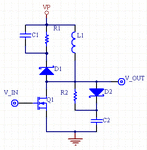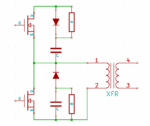R
red_alert
Guest
I'm using an unipolar scheme, indeed. One low-side switch is closed at any time but still the floating point of the other bridge leg has very big voltage oscillations (over DC-link and under GND levels) thus I prefer to put snubbers across every switch. And, as a feedback, all snubber resistors (high-side and low-side) are getting warm almost equally.
At first, I was just using big TVS diodes alone (3 x 5kW rated) across every switch but they were getting hot very fast. The DC-link voltage was 24V (it will be 48V at the end) and the TVS diodes were 75V rated (the MOSFETs are 200V rated though).
Anyway, the switching noise is highly disturbing the high-side bootstrap supplies thus I won't run any further test until I'll finish those separate/isolated power supplies for every MOSFET driver.
At first, I was just using big TVS diodes alone (3 x 5kW rated) across every switch but they were getting hot very fast. The DC-link voltage was 24V (it will be 48V at the end) and the TVS diodes were 75V rated (the MOSFETs are 200V rated though).
Anyway, the switching noise is highly disturbing the high-side bootstrap supplies thus I won't run any further test until I'll finish those separate/isolated power supplies for every MOSFET driver.


